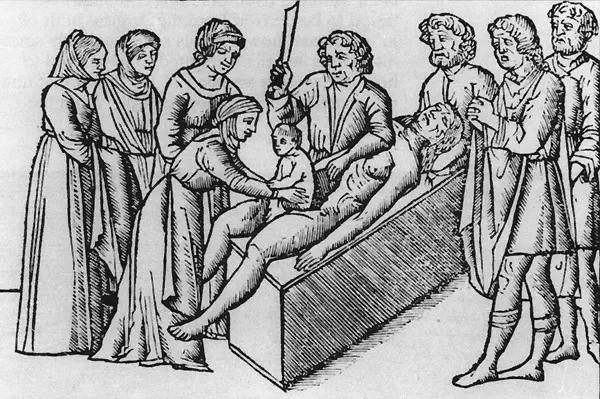Childbirth, while a natural process, has historically been fraught with peril for mothers. Even with modern advancements like opioid pain relief and improved sanitation, which have significantly increased maternal safety compared to centuries past, the history of childbirth is marked by dangerous and often desperate measures.
 Antique surgical instruments including a chainsaw
Antique surgical instruments including a chainsaw
In the annals of medical history, particularly before the 19th and 20th centuries, surgical interventions during childbirth were often risky and considered a last resort. Cesarean sections (C-sections), for instance, were exceptionally dangerous. A stark illustration of this is the first recorded successful C-section in Switzerland in the 1500s, purportedly performed by a cow castrator on his wife. The account, however, is debated by historians due to its unbelievable details, including both mother and child surviving and living to ripe old ages in a time when life expectancy was considerably shorter.
The narrative of early C-sections in the United States paints a similar picture of high-stakes decisions and rudimentary conditions. The first documented case in 1830, recounted by Dr. John L. Richmond in the Western Journal of Medical and Physical Sciences, describes a desperate scenario where a woman in prolonged labor was near death. Dr. Richmond, faced with limited resources and in a newly built log home with gaping holes and flickering candlelight, made the life-altering decision to perform a C-section. His account vividly portrays the precariousness of the situation, using only basic pocket instruments and struggling with poor visibility and no assistance. He succeeded in saving the mother, highlighting the extreme measures sometimes necessary, but also the inherent dangers of such procedures at the time. C-sections were unequivocally a last resort, often performed when all other options were exhausted and the mother’s life was in imminent danger.
Before the relative safety of modern C-sections, a more common surgical procedure was the symphysiotomy. This involved severing the pubic symphysis, a joint in the pelvis, to widen the pelvic opening and facilitate childbirth. Like C-sections, symphysiotomies in this era were fraught with risk, demanding both speed and precision from the surgeon. Success depended heavily on the manual skill of the operator.
This need for a more efficient and effective method for symphysiotomies led to a surprising invention: the chainsaw. In the late 18th century, two Scottish doctors, John Aitken and James Jeffray, developed an early chainsaw prototype. This wasn’t for felling trees, but for medical use, specifically for symphysiotomies and the excision of diseased bone.
The design of this medical chainsaw was inspired by a watch chain, featuring teeth that moved via a hand crank. Imagine the scene: instead of the roaring power tool of the timber industry, a woman in labor would have faced a doctor manually cranking a toothed chain against her pelvis. While perhaps less intimidating in appearance than a modern chainsaw, its function was undeniably similar.
Obstetricians and gynecologists of the time quickly recognized the advantages of this new instrument. Chainsaws offered a significant improvement over previous methods for performing symphysiotomies, allowing for more controlled and potentially faster procedures. The adoption of the chainsaw in the medical field marked a significant, albeit unexpected, advancement in surgical techniques.
The medical chainsaw was later mechanized in the 19th century, further enhancing its ease of use in obstetric procedures. However, its reign in medicine was relatively short-lived. The invention of the Gigli twisted wire saw, particularly effective for bone cutting, soon superseded the chainsaw in medical applications.
Ironically, the mechanized chainsaw, after its brief but impactful stint in medicine, found its true and lasting calling in a completely different industry. Around 1905, the mechanized chainsaw was adopted by the timber industry. The instrument originally designed to ease childbirth and perform delicate bone excisions was repurposed to fell trees, marking a dramatic shift from the operating room to the forest, and forever changing the landscape of logging and, unexpectedly, hardware stores worldwide.
REFERENCES
(Implicitly from the original article – no explicit reference list requested in prompt)
